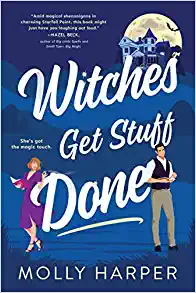My Writing Process: Research Rabbit Holes and Bad Dancing

A lot of readers asked about my writing process, and since I just started a new project, I thought it would be a good time to blog about that.
With all books, I start with a blank document. It’s the SCARIEST THING IN THE WORLD. There is nothing more terrifying to a writer than “no words.” A lot of authors work with fancy organizational programs and those are great. They’ve just never worked for me. If I really want to get involved, I'll write out chapter highlights on index cards and pin them to a board on my office.
I’m lucky enough that sometimes I can sell a project based on a summary. So, I write what would be “cover copy” for the back of the book- a VERY rough outline of the story, that really leaves more questions than answers. (Mwhahaha). That gets copied and pasted into the working document, so when I start writing in circles and panic, I can refer back to what I started writing to reset my brain.
You would be shocked at how often I need to do that.
So, writing. I usually start with the characters and a rough idea of what the story will be about. (I’m trying to keep the details a little sketchy on my current project because of spoilers.) But let’s say in this case, I’m writing a Half-Moon Hollow book and it involves a member of Jolene McClain’s pack. I use a book called THE COMPLETE WRITER'S GUIDE TO HEROES AND HEROINES: SIXTEEN MASTER ARCHETYPES by Tami Cowden, Caro LeFever and Sue Viders. The authors give you all kinds of information about different female and male archetypes and how they interact. It doesn’t give you everything, but it’s an excellent starting point.
I write down a list of traits, how the characters react to things, and how they would react to each other (their meet-cute, what leads to their first kiss, what wacky situation will inevitably lead to their first love scene.) Sometimes snatches of dialogue will come to mind. Also, I have to review some of previous books because it’s been a while since I’ve written about Jolene’s family. I’ve forgotten a lot of names. *internal wincing*
And then I refer to a “screenwriting timeline” that I got during a seminar taught by Alexandra Sokoloff. I’m not comfortable sharing someone else’s materials, but her book SCREENWRITING TRICKS FOR AUTHORS is an excellent resource. The timeline operates from a three-act structure, including establishing relationships, dilemma-building, and when to time dramatic climaxes. I don’t always fill in every point in the timeline, but having it available to refer to really helps to keep me in line, when I tend to write in tangents and lose sight of “Oh, there should be some plot mixed in with all these snarky conversations.”
Generally, I’m doing some research during this phase as well. I have a very well-documented research library full of all kinds of weird books, plus the internet is a treasure trove of information. (Be careful with that. You can fall down the research rabbit hole… and get some remarkable viruses.) Research is important, not only for authenticity, but because really interesting plot ideas can come from the weirdest places. Your brain is just waiting for new data to turn into a really creative sex scene.
I take research notes. Sometimes I leave myself notes in my little bedside notebook when ideas come to me in the middle of the night. (Be careful there, too. Your family could find those notes. My husband had SO many questions when he found a scrap of paper that said, “GRANDPA MUST DIE.” Another reading, “SHE’S A CARNY,” led to a very interesting conversation.)
After I stop procrastinating with prep, I start on a regular 9-5 working schedule. A mass market paperback type novel is about 75,000 words. Some writers are great at working in a linear fashion, but I tend to write in “patches.” Sometimes, I just want to write certain scenes or conversations, and then I go back and write the “connective tissue” between them. I try to write two thousand words a day, every weekday. That doesn’t always happen because life gets in the way. If I feel I’m falling behind or I really close to a deadline without a finish in sight, I check myself into a local hotel and lock in for a weekend. I can usually write ten thousand plus words on those weekends. It takes me 2-3 months to finish a book, depending on how the writing is going. Keep in mind there are some days where I delete entire pages of previously written work... and go cry a little.
I tend to edit as I progress, but I still try to read through and revise at least twice before I turn a project in to my editor. After I finish, one of two things happen:
-If it’s late at night, I climb into bed with my husband, shake him awake to tell him I’m finished. He mumbles, “Congratulations, honey.” And goes back to sleep.
-If I finish during the day (it rarely happens during the day), I will tell my family I’m finished and then do “the dance.” Picture Elaine from Seinfeld with her weird “little kicks.” It’s a lot like that. My kids find this hilarious. We usually go out for a nice dinner to celebrate and then I take a day or two off to catch up on errands, housekeeping, or just let my eyes and brain rest.
And then, because I write multiple projects per year, I get right back on my laptop and start all over again.














